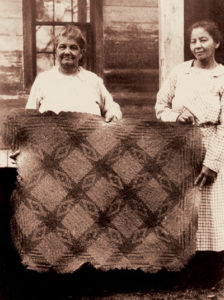Winter 2016
Arbitrary Process
The struggle for federal recognition continues for several of Louisiana's Indian tribes
Published: December 12, 2016
Last Updated: November 9, 2020
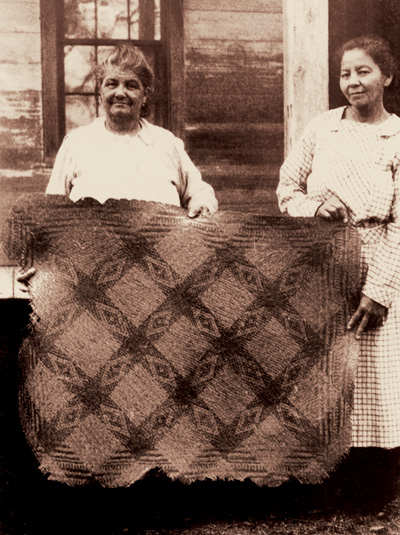
Courtesy of Cammie G. Henry Research Center, Northwestern State University of Louisiana.
Chitimacha weavers Christine and Pauline Paul with a rivercane mat, Little Trout design, ca. 1930.
The Isle de Jean Charles is inhabited by citizens of two Indian tribes, the Isle de Jean Charles Band of Biloxi–Chitimacha–Choctaw Tribe (BCC) and the United Houma Nation (Houma). “Indian” is a term defined over a dozen different ways under federal law, serving as both a racial and political classification. Although the federal government admits the BCC and Houma are composed of persons who are members of the Indian race, neither tribe is federally recognized. Without federal recognition, citizens of the Houma and BCC are not considered citizens of a sovereign Indian nation.
The implications of tribal sovereignty are immense and hotly contested. Indian gaming is the best known and most controversial aspect of tribal sovereignty, but countless other issues have arisen over tribal sovereignty, including marijuana legalization, adoption and payday lending. Federally recognized tribes are eligible for certain government assistance programs as a result of their status. These issues have transformed the debate over which tribes are “real” and which are merely seeking the benefits of federal recognition into an extremely political matter.
Federal recognition grants tribes a government-to-government relationship with the United States. As “domestic dependent nations” under federal law, these tribes have a sovereign status like that of states. This was famously noted by Chief Justice John Marshall in 1832 when he ruled that, inside the boundaries of the Cherokee Nation, “the laws of Georgia can have no force.” Tribal sovereignty results from the acknowledgment that tribes existed as nations long before the European “discovery” of America. The position of tribes as nations is confirmed by their entreating with the United States and various European governments; the Constitution regards treaties as the supreme law of the land.
Today, there are 567 tribes recognized by the United States. Approximately 90 percent of these tribes were part of the first official list of recognized tribes published by the Bureau of Indian Affairs (BIA) in 1979. Most of these tribes made their way onto the list because they were named in the Indian New Deal of 1930s or were Alaska Native groups that maintained a government-to-government relations with the United States. Several other tribes are currently seeking federal recognition. Over the last 40 years, tribes have gained recognition through one of two ways: legislation or the administrative federal acknowledgment process. While the legislative process is by nature political, the administrative process was supposed to provide an objective answer to which groups are “real” tribes. As demonstrated by the case of Louisiana’s Houma Nation, the administrative recognition process failed to meet its goal.
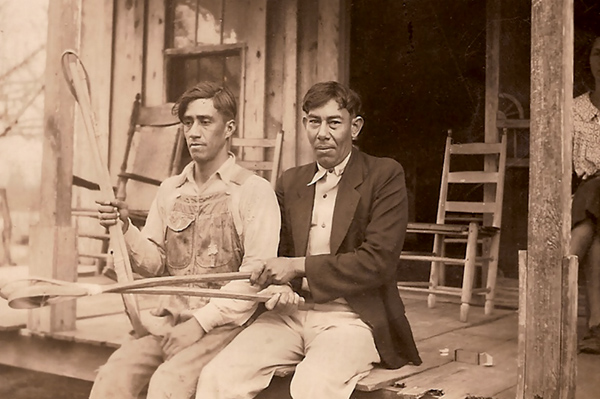
Merlin Pierite and Joseph Pierite of the Tunica-Biloxi Tribe of Louisiana with stickball raquettes, ca. 1930. Courtesy of Williamson Museum, Northwestern State University, Frank Speck Collection
Establishing the Process
The administrative procedures were created during the 1970s, a time when Indian policy changed drastically. From the 1950s to the late 1960s, the federal government’s official policy towards tribes was termination. More than 100 tribes had their relationship with the federal government terminated during this period, and the government provided Indians with bus tickets from their reservations to major U.S. cities as part of the Urban Indian Relocation Program. Relocated Indians were promised good paying jobs and housing, but like so many of the government’s commitments to the Indians, the promise went unkept. President Nixon formally ended this abysmal era in 1970.
By the 1970s, the “Red Power” movement had helped boost pride in Indian ancestry, sparking an increase in the number of tribes seeking federal recognition. The American Indian Policy Review Commission was an outgrowth of the federal policy shift and changing cultural attitudes towards Indians. The Commission studied numerous areas of Indian policy, including federal recognition. Finding that no guidelines existed for recognizing a tribe, the Commission reported that the government’s decisions were largely arbitrary. The government attempted to remedy the situation by establishing a new set of administrative recognition procedures in 1978.
Despite revisions to aspects of the process over the years, the requirements have remained essentially the same. Indian groups petitioning the government for federal recognition must satisfy seven criteria:
- The petitioner has been continuously identified as an American Indian entity since 1900.
- The predominant portion of the petitioner has comprised a distinct community from historical times to the present.
- The petitioner has exercised political influence over its members from historical times to the present.
- The petitioner must provide a copy of its current document and membership criteria.
- The petitioner is composed of members who descend from a historical tribe or tribes that combined to form a single tribe.
- The petitioner’s members are not enrolled in a federally recognized tribe.
- The petitioner is not barred from federal recognition
The administration of the process has been the subject of intense criticism since its inception. During a 2012 senate hearing on federal recognition, Senator Daniel Akaka stated, “The length of the process, interpretation of the criteria, and staffing needs have been raised countless times at Committee hearings. Sadly, little has changed with the process and many of the issues raised decades ago still remain unresolved.” A senior policy advisor for the Office of the Assistant Secretary for Indian Affairs echoed Senator Akaka’s concerns during the hearing.
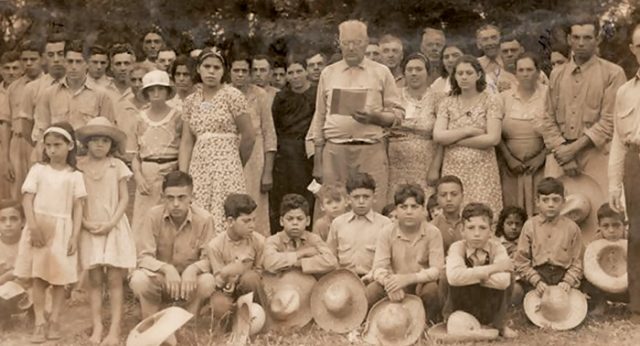
Isle de Jean Charles mission school, ca. 1930. Courtesy of Houma Nation
Other critics point to inconsistent results and long delays in rulings. The process grants federal bureaucrats tremendous latitude to interpret petitions however they desire. Anthropologist Steve Austin, who formerly worked in the BIA’s Branch of Acknowledgment and Research, stated the department could “shut down [all petitioners] if we wanted to.” Multiple Government Accountability Office reports acknowledge the failures and widespread criticism of the federal recognition process, and the U.S. Office of Inspector General has investigated allegations of corruption in the process. John Norwood, co-chair of the National Congress of American Indians Task Force on Federal Acknowledgment, asserts that 72 percent of the presently recognized tribes could not withstand the acknowledgment process if they were to reapply today.
One persistent complaint from critics of the administrative process is that tribes hoping for federal recognition are expected to conform to Anglo-American stereotypes that all Indians—even in the modern world—eschew cars for horses and live in teepees, when in reality Indian culture has always been diverse and evolving. In other words, Anglo-American perceptions of community and political authority influence the process. A criterion for petitioners is the historical status of a tribal political structure, as imagined by Anglo-Americans; historically, however, many Indian tribes did not have a prototypical central government that would dictate how individual Indians lived their lives. Instead, the family, or other small bands of people, often comprised the major governing unit. The administrative recognition process forces tribes to abandon their traditional governing structures in order to be deemed a tribe by bureaucrats.
Louisiana’s Federally Recognized Tribes
Louisiana is home to four federally recognized tribes. Two of the tribes achieved federal recognition prior to the creation of the administrative acknowledgment process. In 1916, the Chitimacha became the first tribe in the state to gain federal recognition. Tabasco heiress Sara McIlhenny took an interest in the Chitimacha and used her influence to help the tribe obtain recognition to prevent further loss of its land. In 1935, the Coushatta became the second Louisiana tribe to become federally recognized when the government began providing tuition funds to the tribe’s children. The Coushatta’s recognition ended in 1953, during the Termination Era, but Coushatta leaders began actively pursuing federal recognition in the 1960s. The tribe gained recognition by the Secretary of the Interior in 1973.
The Tunica–Biloxi Tribe of Louisiana was the first tribe in the state—and among the first in the nation—to pass through the administrative recognition procedures established in 1978. The contemporary Tunica–Biloxi is a combination of the Tunica, Biloxi, Ofo and Avoyel tribes. Tunica–Biloxi federal recognition efforts gained urgency during the Great Depression. After an unsuccessful trip to Washington, D.C., in 1938 to petition for acknowledgment, tribal leaders began to seek allies among two recognized tribes in the region, the Mississippi Band of Choctaw Indians and the Chitimacha. In the late 1960s, the Tunica–Biloxi were able to earn the support of the National Congress of American Indians and its then director, acclaimed scholar Vine Deloria Jr. The tribe formally incorporated in 1974, and a year later, it was formally recognized by the State of Louisiana. Governor Edwin Edwards sent a letter to the Senate Committee on Indian Affairs pleading for the tribe’s recognition. The federal government published receipt of the Tunica–Biloxi’s petition to enter the process in December 1978 and granted the tribe federal recognition in September 1981.
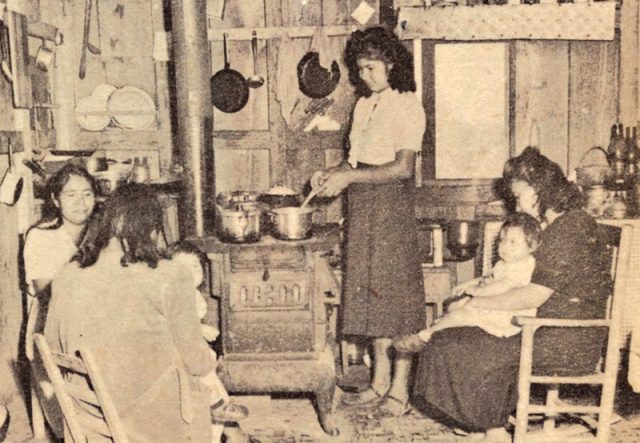
Members of the Chitimacha Tribe of Louisiana prepare supper at home. Courtesy of McNeese State University
In 1995, the Jena Band of Choctaw Indians became the most recent Louisiana tribe to achieve federal recognition. Although Choctaw Indians roamed throughout Louisiana prior to European contact and well into the 1800s, historians are uncertain of how the Jena Band of Choctaw Indians ended up in Jena. No one ever doubted that the Jena Band were Choctaw, but being undeniably Choctaw is not enough for a tribe to attain federal recognition. The Jena Choctaw began its push for federal recognition in 1974 when the tribe officially incorporated. The Choctaw had no formal government historically but adopted one to meet the government’s criteria. Louisiana officially recognized the tribe that year and requested the federal government do the same. Unwilling to wait the 15 to 20 years typically required by the process, the Jena Choctaw asked Senator Bennett Johnston to introduce legislation to recognize the tribe. After two unsuccessful attempts by Johnston, the legislation passed both houses of Congress only to be pocket vetoed by President George H.W. Bush. The Jena Choctaw faced opposition from several tribes who feared that recognizing another tribe would reduce their share of federal funding available. Gaming politics also complicated the tribe’s recognition. The Jena Choctaw’s efforts ultimately succeeded in large part because of support from other federally recognized tribes, most notably the Mississippi Choctaw. The Jena Choctaw’s small size, fewer than 200 members, made community relatively easy to prove, as did the fact that many Jena Choctaw did not speak English until the 1930s.
Louisiana Tribes Still Seeking Federal Recognition
In addition to the four federally recognized tribes, ten other tribes are officially recognized by the state of Louisiana. Though largely symbolic, state recognition makes tribes and their members eligible for certain state benefits and some federal benefits, like the Small Business Administration’s 8(a) Business Development Program and the Indian Arts and Crafts Act. Of all the tribes seeking acknowledgment, those along Louisiana’s coast—the Houma, BCC, and Pointe-au-Chien Indian Tribe of Louisiana (PAC)—have perhaps the most complex federal recognition story in the nation.
Europeans made first contact with the Houma in 1699 at present-day Baton Rouge, named for the red stick used to mark the Houma’s border with the neighboring Bayougoula tribe. A decade later, the Houma migrated south towards New Orleans and defended New Orleans against other Indian tribes. The Houma began incorporating other tribes into their ranks in the mid 1700s. In 1769, the Houma and several other tribes participated in a medal ceremony with Spanish governor Alejandro O’Reilly; medals were a common means for Western governments to formalize relations with Indian tribes. The Houma began migrating to what would become Terrebonne and Lafourche parishes around 1800. As part of the Louisiana Purchase in 1803, the United States pledged to honor agreements between Spain and the Indians. Governor William C. C. Claiborne bestowed recognition upon the Houma in 1811, and in a backhanded fashion, the federal government recognized the Houma as a tribe when it denied the Houma’s land claim in 1817, stating, “We know of no law of the United States by which a tribe of Indians have a right to claim lands as a donation.”
The City of Houma was founded in 1834 and named for the Houma who lived in the area. The Houma lived largely in isolation in the swamps and bayous until renowned anthropologist John Swanton visited them in 1907. Swanton concluded the Indians he met in Terrebonne and Lafourche were the descendants of a medley of Indian tribes, but “the Houma was always the dominating element.” The BIA visited the Houma in 1931. The Houma’s authenticity as a tribe was not an issue; nonetheless, the BIA refused the Houma aid because they were too “scattered” along Louisiana’s coast.
Houma life began to change in 1917 when the first natural gas plant opened on their land. Oil companies became increasingly interested in Houma lands during the 1930s, leading to the massive dispossession of Houma lands—primarily by legal means. BIA anthropologist Ruth Underhill gloomily wrote in 1938 that the Houma did not go in for white marriage certificates, and the state would not recognize marriages in the Houma tradition. As a result, Houma children were illegitimate under Louisiana law and thus not allowed to inherit property. Houma lands were also dispossessed of their land through quitclaims, tax sales, and coercion.
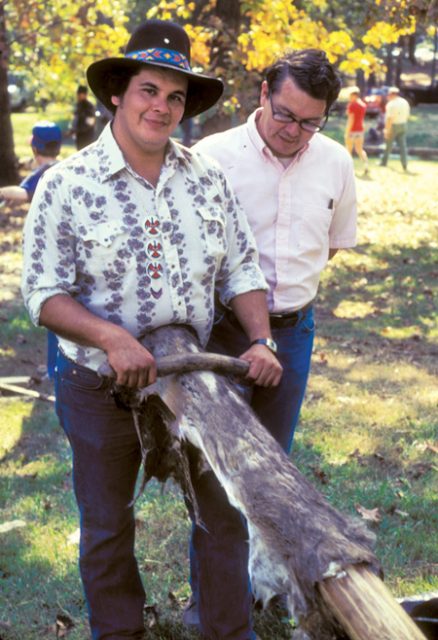
George Allen of the Jena Band of Choctaw Indians graining deerskin, ca. 1975. Courtesy of Northwestern State University, Gregory Collection.
Racial discrimination has always been a fact of life for the Houma. A three-way system of segregation existed for “[v]irtually all institutions” in Terrebonne and Lafourche parishes. Local whites in the parish often referred to Houma by the pejorative “sabine,” a term that if used today will still ignite a fight from many Houma elders. In 1944, a school for Indians was established in Terrebonne Parish; soon after, Lafourche Parish opened its own Indian school. The Civil Rights Act officially ended segregation in public institutions in 1964, but Houma children remained in segregated Indian schools until 1969.
The Houma were one of the four initial tribes named to the Inter-Tribal Council of Louisiana in 1974, and the state granted the tribe recognition in 1977. The Houma submitted its petition for federal recognition on July 10, 1979. The slow pace of the process prompted the Houma to attempt legislative federal recognition in 1989. Oil companies blocked the bill, and the Louisiana Land and Exploration Company (LLE) began active opposition to the Houma federal recognition petition during the 1990s. Professor Mark Edwin Miller, author of two books about federal recognition, stated LLE took depositions in an attempt to undermine the Houma’s recognition efforts because to LLE “it was clear that tribal acknowledgment would give the Houmas standing in court to press claims under federal Indian laws.” More recently, BP denied Houma claims following the Deepwater Horizon oil spill in 2010 due to their lack of federal recognition.
In 1994, the BIA declared the Houma had failed to meet three criteria for federal recognition. While acknowledging that “Indian ancestry can be verified for the petitioner without doubt or question,” the BIA issued an odd timeline for the tribe, determining that the Houma were nonexistent until 1830, existed as a tribe from 1830 to 1880, then subdivided into six or more tribes after 1880. Most peculiarly, the BIA found “no evidence” that the Houma descend from a historic Indian tribe.
The BIA’s assessment of the Houma’s petition has been critiqued by academics. Widely regarded as the foremost expert on Southeastern Indian tribes, Swanton stated that the Houma he visited in 1907 were descended from the Houma tribe that encountered French explorers. Numerous scholars accept Swanton’s research, yet BIA—which has acknowledged Swanton’s work in the successful petitions of several other tribes—claims any links between present-day Houma and the Houma of old are “unfounded.” Similarly, virtually everyone who has studied the Houma has concluded the Houma migrated south to Terrebonne and Lafourche parishes. The BIA, however, is not buying it.
The seemingly arbitrary historical findings do not end there. The BIA has been unable to discern a link between the City of Houma and the Houma tribe. In fact, the BIA contends that the Houma could have been named for the city rather than the city being named for the tribe living in the area, as is common throughout the United States.
The BIA made another strange historical interpretation when discussing a Houma ancestor from the late 1700s and early 1800s named Louis Le Sauvage. The name’s translation is “Louis the Indian.” Assuming that a person who is named “The Indian” while claiming to be an Indian and living with Indians in the Louisiana bayous is in fact an Indian seems logical. Indeed, the BIA admits there is a “strong possibility” that Mr. Sauvage was Indian based upon his being a Houma chief and his sister having an “Indian name.” Nevertheless, the BIA could not verify Mr. Sauvage’s ancestry and asserted Mr. Sauvage may have been Flemish.
Within a year of the negative finding, the BCC and PAC split from the Houma and submitted their own separate petitions to the federal government. Both the BCC and PAC share the same history as the Houma. Members of all three tribes are kin and many in the PAC and BCC were previously enrolled in the Houma. It is perhaps an oversimplification to say that the PAC and BCC left the Houma because of the BIA’s negative proposed finding on the Houma petition; members of the PAC were discussing separating from the Houma a year before the BIA ruled against the Houma. While parts of the PAC and BCC petitions are directly lifted from the Houma petition, the PAC and BCC do not claim descent from the historical Houma tribe. The BIA has denied both tribes’ recognition petitions for failing to meet the same criteria as the Houma.
Enduring Injustice
In September 2016, France celebrated its 317-year alliance with the Houma Nation—acknowledging the contemporary Houma as the descendants of the Houma who greeted French explorers centuries ago. The United States, nevertheless, has been formally trying to decide whether the Houma is a tribe for over three decades. The Houma, BCC, and PAC, long the victims of discrimination based upon their Indian ancestry, linger in the recognition process as the land that shaped their culture washes away.
Adam Crepelle is an attorney and has a master’s degree in public policy from Pepperdine University. He is a citizen of the United Houma Nation and serves on the California Indian Law Association’s board of directors.
